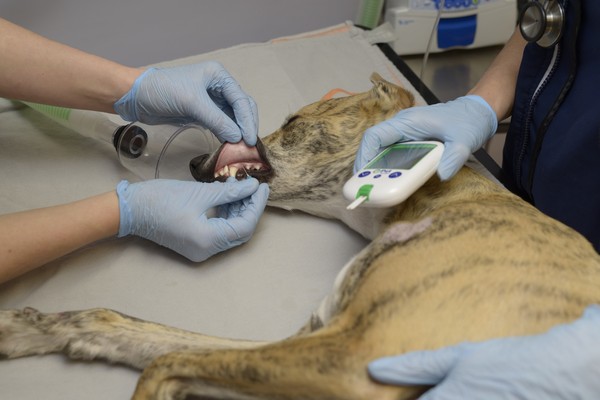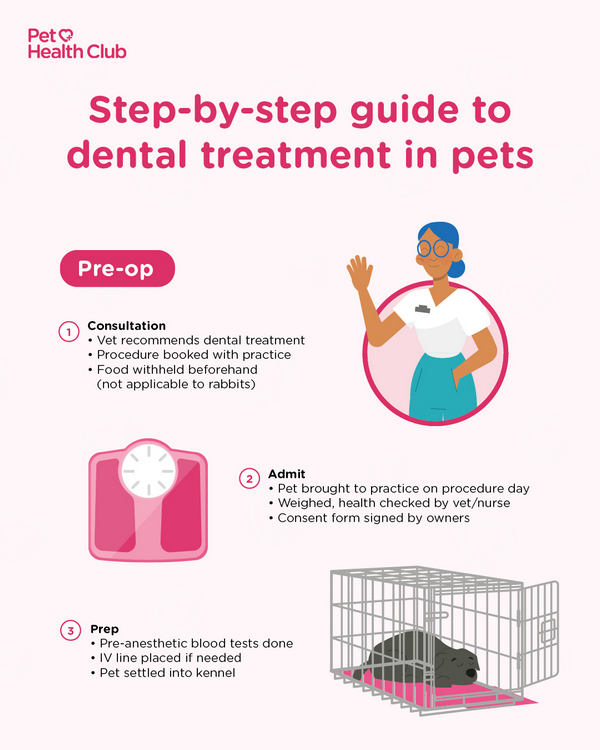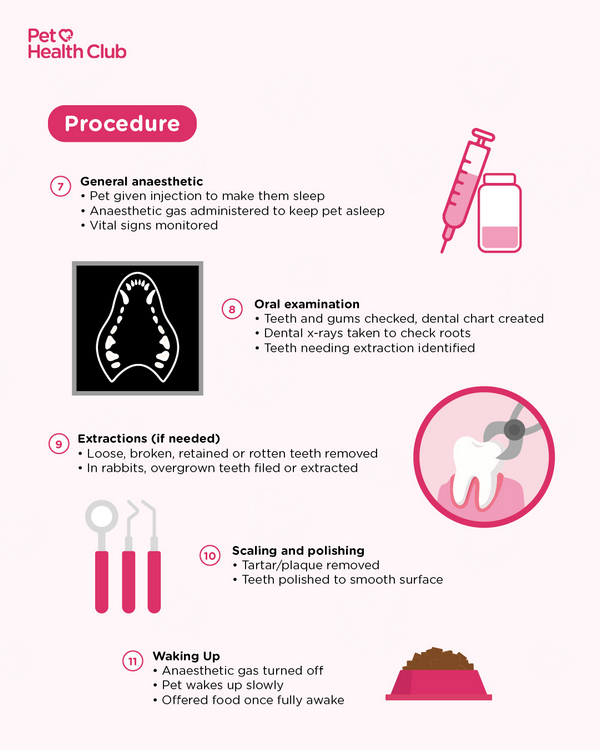Step-by-step guide to dental treatment in pets
Similar to humans, pets accumulate plaque on their teeth over time, especially if they’re not brushed regularly. This sticky mix of sugars and bacteria can lead to tartar buildup, gum disease, infections, and even tooth loss if left unchecked.
Dental treatments help remove plaque, minimise tartar, and lessen the risk of decay or disease affecting the teeth and gums. Maintaining your pet's oral health isn't just about their teeth, either — poor dental hygiene has been linked to wider issues like heart, liver, and kidney problems due to oral bacteria entering the bloodstream.
If your vet has recommended a dental procedure for your pet, such as a scale and polish or tooth extraction, you may feel anxious — but there's no need to worry. This guide will walk you through exactly what to expect, from the initial consultation to post-operative care at home.
Consultation
The process always begins with a consultation. Your vet or vet nurse will have examined your pet's mouth and found signs of oral disease, such as red, inflamed gums, excessive plaque and tartar, or tooth lesions. If dental treatment is recommended, now is the time to discuss timings, costs, and whether any x-rays or blood tests might be necessary before the procedure.
The vet receptionist will then schedule your pet's procedure for a suitable day. To lower the risks associated with anaesthesia, you’ll also be asked to prevent your dog or cat from eating for a specific period before the procedure, though rabbits should continue eating to aid their digestion.
Admission and preparation
On arrival at your practice, a member of the team (probably a vet nurse) will welcome you and your pet, weigh them, and review the consent form (be sure to provide a contact number for the day). They'll then double-check your pet’s vital statistics to ensure they’re fit and healthy for anaesthesia.
Once admitted, your pet will be settled into a kennel and given reassurance to help them feel at ease. If any preoperative blood tests are required, these will be performed while your pet is still awake. Your pet may be given a mild sedative drug around an hour before their procedure, to relieve anxiety and relax them.
Please note that the dental treatment process may vary depending on the vet practice you visit. Always consult your vet for specific details and recommendations tailored to your pet's needs.
Under anaesthetic
The next step is administering the anaesthetic, with the vet carefully calculating the dosage based on their size and breed.
Once your pet is asleep, a soft tube will be placed in their airway to deliver a continuous flow of oxygen and anaesthetic gas, keeping them asleep but breathing normally. A veterinary nurse will constantly monitor your pet while they’re asleep.
Dental procedure
The vet surgeon will start the dental procedure once your pet is fully anaesthetised and their vital signs are being monitored.
First, they’ll carefully check your pet’s mouth, using charts and x-rays to guide them. All aspects of the mouth are checked, including each individual tooth, the gums, cheeks, and tongue. Notes are charted of any missing, loose or damaged teeth, the amount of tartar buildup and the condition of the gums.

If extractions are required, the vet will skillfully remove any affected teeth, stitch the gum if needed, and take post-operative x-rays to remove all fragments.
Finally, the remaining teeth are cleaned. Using special ultrasonic scalers and fine instruments, the vet will carefully remove any hardened tartar from the tooth surfaces and under the gumline where it accumulates. They will then polish the remaining teeth.
Waking up
When the procedure is finished, the veterinary nurse will turn off the anaesthetic gas and your pet will slowly start to wake up whilst breathing in oxygen to support their recovery. The veterinary team will monitor your pet carefully until fully awake, and offer comfort and reassurance.
Once fully conscious and stable, your pet can return to their kennel to recover under supervision until you arrive for pick-up. The nurses will let you know about the procedure, any issues that need to be monitored and arrange a suitable time for your pet to be picked up.
Feeling slightly groggy after anaesthesia is normal. Expect your pet to be drowsy and lacking appetite until the effects fully wear off over the next 24 hours. Offer small amounts of food, have fresh water always available and allow them plenty of rest. Your pet may dribble some saliva, which may be tinged with blood. This is perfectly normal, with no need for concern unless a lot of blood is seen.
Going home
Most pets bounce back from a dental procedure after just one or two rest days, but you should receive thorough home-care instructions to help with their recovery, such as temporarily providing soft foods if any teeth were extracted. Pain medication and/or antibiotics may also be prescribed. Be sure to follow the guidelines you’re given.
You'll also need to schedule a follow-up appointment with your vet so they can check everything is progressing well. The first appointment is likely to be a few days after the dental treatment, and then beyond that, your vet may recommend homecare strategies such as tooth-brushing, and ongoing dental check-ups.
Need more advice on dental care?
For expert advice, use our find a vet page to find your nearest vet, or speak to a vet online using our video vet service.
Remember, prevention is always better than cure, so start taking steps today to protect your pet’s teeth. Members of Pet Health Club get six-monthly dental check-ups and 10% off dental procedures as part of their benefits.
*Please note that the dental treatment process may vary depending on the vet practice you visit. Always consult your vet for specific details and recommendations tailored to your pet's needs.






